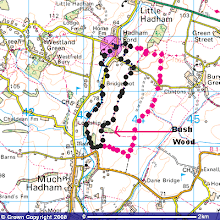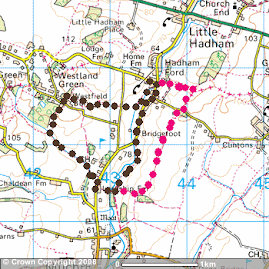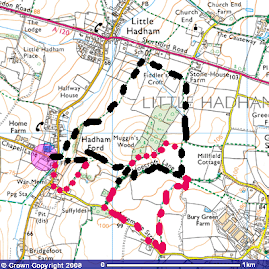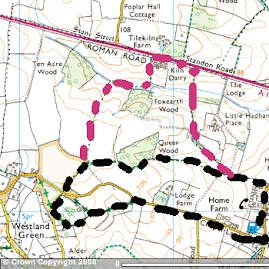Just a quickie. Having finished my supper, I ventured outside for my evening nicotine, only to disturb a woodcock from the garden. It crashed its wings, heading off northwards up the valley. A fly by silhouette of down pointing beak and fat, pot bellied shape were the main give aways, along with the whirring wings. Great sound.
Be good to find this species roding in the area. Males tend to fly at tree height as from mid April, calling with a most distinctive sound. I suspect woods around here may hold resident pairs.
A record of the wildlife in and around Hadham Ford as from January 2008. Please feel free to leave any comments or email me with details of interesting bird, mammal, butterfly, moth and dragonfly sightings. @jonoForgham on twitter
Wednesday 30 January 2008
Few minutes in the garden at dawn
Spent a couple of minutes listening to the increase in bird song this morning. Robins, as usual were predominant, with at least 6 singing in the dark. A lone song thrush sang from around the chapel allotments whilst a startled blackbird flew into the hedge by the chapel. A fox called from the woods opposite the pub and the jackdaws were marauding around at first light. A pheasant called from the field adjacent to Ford Field.
As the daylight increases in the mornings I will be out earlier, listening and noting the increase in bird species developing a territory. By the end of February many birds will have established a territory, or in cases like wren and dunnock that can have several females on the nest at the same time, several territories. By mid April the dawn chorus will be at its peak and then is the time for an early dawn walk. This can establish exactly which birds are in the area without actually observing them.
As the daylight increases in the mornings I will be out earlier, listening and noting the increase in bird species developing a territory. By the end of February many birds will have established a territory, or in cases like wren and dunnock that can have several females on the nest at the same time, several territories. By mid April the dawn chorus will be at its peak and then is the time for an early dawn walk. This can establish exactly which birds are in the area without actually observing them.
Sunday 27 January 2008
Glorious Sunday morning

Finally completed the quartet of patch walks this morning between 9.00 - 11.00am. Walked east up Brick Kiln Hill and then headed south along the ridge to Winding Hill in Much Hadham before following the same route along the River Ash as used on the south west wander. Superbly clear morning with bright light. 29 species in all with the highlight being as I was removing my boots at the front door!
However, the usual Little Hadham birds were registered as I walked to the ford (jackdaw, rook, chaffinch, tits, thrushes etc) Upon the hill, by Field House a small flock of goldfinches went over. A search for treecreeper in lane hedgerows was unsuccessful but as I wandered towards Much Hadham a calling lapwing attracted my attention. A flock of 6 were then observed on the plough. Shortly after a lone herring gull lazed its was north, followed soon after by a flock of 16. A wander into a small coppice (Bush Wood) realised two green woodpeckers and one Great spotted. A suspected nuthatch was heard chipping away on a dead tree stump, but no views. Plenty of deer prints in the mud around a small pond means I shall pop back to see if I can get a photo or two.
Dropping down to the river valley proved fruitful, as I soon recorded the first mistle thrush of the weekend. Calling goldcrests in a conifer meant a five minute search before I observed two flitting around in the needles. They were accompanied by two marsh tits. I stopped here to photo the newly emerged snowdrops and also took the shot seen above, looking north up the now much quieter and emptier Ash.

A kestrel showed over Bridgefoot Farm before I arrived back home. As I was removing my boots 2 jackdaws called in an angry manner and I looked up to watch them mob a common buzzard. It circled over the house giving great binocular views. Pale underwings with strong barring were noted. Buzzard plumage can vary enormously, so worth keeping a note to compare with others I may chance upon. 4 new species for the village list.
Saturday 26 January 2008
Saturday wander


This morning, a rare bright and mild day, I set off to check previously aforementioned large finch flock on the south footpath some 600 yards before Winding Hill, Much Hadham. A walk along the River Ash gave 3 new species for the year. Firstly a superbly plumaged male bullfinch was noted in the hedge opposite Bridgefoot Farm. A walk to the "finch field" gave up usual corvids and pigeons along with good numbers of winter thrushes. No flock of finches were observed, they have obviously moved on. On the return walk I mused over what birds may be present over the ensuing months. The red brick shelter in one field looks good for an owl roost and swallow nestings, whilst the muddy riverbed looked like it should hold snipe. Within a minute, I flushed three snipe from the muddy patch on a meander. They flew high, circling before heading off east. Good bird to see and 4oth on the village list. The river level has dropped markedly since last weekend. I arrived back at Chapel Lane just in time to record a marsh tit on the feeder in the garden of one of the Ford cottages. Another expected species but all the same a pleasure to watch. In an attempt to find my camera the bird flew overhead on to bushes on Brick Kiln Hill. However, I shall venture down again as I suspect it feeds regularly on the nuts offered.
Whilst heading out of the village I called hello to a chap tinkering with his car, only to discover it was a chap I knew 20 years ago from Stortford. Not seen him for a fair while. Good to see you and Jill again, Andy.
The top photo is taken where the finch flock had been, looking east along the hedge line with a wonderful sky. The second photo was taken looking west over the footbridge on the path towards Ash Valley golf course.
Monday 21 January 2008
1st south west walk

On a dry and mild Sunday morning I set off on a new walk, taking in the area south west of home (see map to the right). A considerable amount of this area is Ash Valley golf course, but two footpaths cross the fairways, allowing good access to an area that I suspect will prove fruitful for spring migrants. It is an area of land that is around 90 metres above sea level and therefore able to offer sanctuary to migrating birds such as wheatear and maybe ring ouzel. Today's walk added 5 to the village list. Firstly, a flock of meadow pipits flew over the golf course. These were soon followed by the discovery of 3 reed buntings in a hedge adjacent to Caley Wood. The fungi photo above was taken in the damp wood.
I continued along the hedgerow south of the first holes of the golf course, flushing 4 red legged partridge. A reasonable flock of finches were feeding around a pheasant feeder just before I gained access to the road, crossed over and headed down to the River Ash, just south of Lordship Farmhouse. A footbridge crossed the swollen river. Soon I came across a large finch/bunting flock, probably numbering in excess of 200. Majority were chaffinches with over 40 yellowhammers. Others were goldfinches, greenfinches and a couple of reed buntings. A moorhen called from the adjacent field, making 5 new sp for the walk. I got back to the road at Bridgefoot Farm, where I chatted to the farmer, Mr Camp. I was after an allotment and had been told that he rented some out. Indeed he did and I now have my work cut out to prepare the allotment for sowing by Feb/March.
A splendid walk, realising 28 species of bird and one I must repeat soon as I need to get my telescope down to the finch flock to check if there were any other species mixed in. Brambling or siskin, perhaps? Finally, a muntjac deer, fearless, observed me as I made my way across the fields towards the road and farm
Photo below is taken, looking north along the Ash, with Bridgefoot Farm in the distance.
The photo below shows the junction of Chapel Lane at Ashford House and the Nags Head. In a small paperback book about the village there are several photos of this area going back to 1900's. One particularly shows flooding at the Ford in recent times. The book is by Stephen Ruff, available at Waterstones in Stortford.

Saturday 19 January 2008
General view/Great spotted woodpecker
This photo, taken again from Brick Kiln Hill, looking west illustrates the general layout. In the Ash valley, below the hedge, is the river and Ford cottages as shown on previous photo. The row of cottages marked, including our house is Chapel Lane cottages. These are a row of 7 Georgian buildings, the first three being the old bakery. To the left are the newer properties. Further up the hill, Home Farm and adjoining barn conversions can be seen. The roof of the chapel is just visible beyond the hedge in the centre.
A few damp minutes in the garden this morning produced the first drumming Great Spotted woodpecker of the year. This was heard to the north of the ford near the footpath. Frequent drumming, each one lasting less than a second, is a territorial sound. The lesser spotted woodpecker also drums, frequently making a very similar sound but usually they drum for more than a second. The sound can carry for over half a mile if the bird has selected the best resonant tree. This one certainly had.
Friday 18 January 2008
Hadham Ford


These shots were taken on last Sunday. Clearly a lot of rain had fallen and the ground was awash. These were taken on the easterly walk from around Brick Kiln Hill. The second photo is the fast flowing River Ash at the ford opposite the Chapel Lane junction, near the Nags Head. This is looking south. Unfortunately, the river is frequently dry and rarely this full. The first shot is taken looking west from the footpath heading towards Muggin's Wood. The large red brick house is Ashford House, on the junction with Chapel Lane. Next door is the Nags Head. The chapel can be seen on the left of the lane behind the row of red brick cottages.
Tuesday 15 January 2008
Muddy morning
After heavy rain over the weekend, I ventured out on Sunday morning. I had my first wanderings to the east of Hadham Ford, crossing the fast flowing River Ash opposite the Nags Head and heading off towards Muggins Wood. Gunfire appeared to surround the whole area and it wasn't long before I encountered the beaters and guns on the hill behind Field Cottage. A bag of 6 brace of pheasant and a woodcock had already been collected, with more pheasants added later. Whilst standing behind the guns, I was not dismayed to hear the gunfire and then observe 6 pheasants, unscathed heading over my head.
Further along I encountered good numbers of winter thrushes; redwings heading north, calling from high. A lone skylark called, my first for the area. The hoped for yellowhammers were not to be found, instead a large party of long tailed tits, seen in the large oak tree at the top of Brick Kiln hill. A thorough search through these failed to produce any other species.
On my walk back to te village from the war memorial a lone sparrowhawk was working the side of the hill, scattering tits and finches. Mistle thrushes were watched in an open field, before I returned home, covered in mud. The whole area appeared to be awash. In all, a species count of 27. A few photographs and another map, pertinent to this walk will be added shortly.
In the evening, a chance encounter with both the local farmer and gamekeeper gave me the opportunity to seek permission to enter the private woods that surround the village. This was granted, so many thanks to Paul and Steve for this.
Further along I encountered good numbers of winter thrushes; redwings heading north, calling from high. A lone skylark called, my first for the area. The hoped for yellowhammers were not to be found, instead a large party of long tailed tits, seen in the large oak tree at the top of Brick Kiln hill. A thorough search through these failed to produce any other species.
On my walk back to te village from the war memorial a lone sparrowhawk was working the side of the hill, scattering tits and finches. Mistle thrushes were watched in an open field, before I returned home, covered in mud. The whole area appeared to be awash. In all, a species count of 27. A few photographs and another map, pertinent to this walk will be added shortly.
In the evening, a chance encounter with both the local farmer and gamekeeper gave me the opportunity to seek permission to enter the private woods that surround the village. This was granted, so many thanks to Paul and Steve for this.
Tuesday 8 January 2008
Dawn listening
A brief visit into the garden this morning, before first light, produced at least 3 tawny owls communicating. Mimickery from myself led to a female calling from a tree by the chapel, although not visible. Two mallards were observed by the ford as I left for work, taking the running total for species to 30. Robins and a song thrush were heard in local trees and the resident jackdaw population was just beginning to stir. Plenty of bird activity in the garden throughout the day as the bird feeders (5) , which were filled Sunday afternoon, were all virtually empty. At this rate the cost will be somewhere around £12 - £15 per week for seeds and fat balls! Made up some bird suet food with left over kitchen scraps, Christmas nuts and lard. Maybe this high fat content will mean less feeding and a longer time between replenishing the feeders. I have noted that numbers of coal tits to the feeders are more than expected, with, I think, a maximum of 5 being regular visitors. Now need a local pheasant to return to eat all the wheat grain that the smaller birds seem to leave, which then falls to the ground. Otherwise, will have a proliferation of wheat in the garden later in the year.
Monday 7 January 2008
Afternoon stroll 06.01.08
A short walk around the north West patch between 1.30 - 3.15pm yesterday got the year list for bird species off to a good start. Large numbers of winter thrushes, especially fieldfares were noted. Little else worthy of note was observed. Numbers of chaffinches near a pheasant feeder were in the twenties but a search through failed to produce a wished for brambling or siskin. 2 great spotted woodpeckers were recorded on a bright but increasingly cold afternoon.
Subscribe to:
Posts (Atom)
This is me

At the end of another Norfolk Coastal footpath walk. 47 miles, 3 days 99 species of bird. September 2009
Caley Wood view

sunshine through the canopy 29.05.08
A walk along the Warta Valley, Poznan, Poland. Feb 2007
Best birds on this walk: black and middle spotted woodpecker and short toed treecreeper
About Me

- Jono Forgham
- A primary school teacher for 30 years, I retired from teaching in July 2009 to set up my own science enhancement and communication company. The Primary Works offers science clubs, workshops and staged science shows nationwide. I have always been interested in bird watching since my early years. Apparently my first tick was after inquiring about a chaffinch and then receiving the Observer book of birds. By the age of 9 I had moved on to Tory Peterson's collins guide and was now involved on YOC birding holidays to Northumbria, Essex coast, Slimbridge and Yorkshire. My twitching rule is that I will willingly travel 1km for each gram the bird weighs. However, I have had many rarities just by being in the right place. I have travelled widely throughout Europe and also visited Australia and Sri Lanka. In 2016 I spent time at Portland Bird Obs and two trips to Aviero, Portugal. 2017 found me back in Sri Lanka in Feb/March, then July and back for New Year's Eve celebrations in December. Also returned to The Camargue in May for a 4 day trip. Few plans for 2018, but nothing yet booked apart from a trip to the IOW.
Grey heron

Over the allotment 28.09.08
Southern Hawker

Ridge footpath 27.08.08
Juvenile green woodpecker (17.08.08)

Note the stripes, denoting a bird fledged this year.
common blue

Ash Valley G.C. 15.08.08
Indian balsam (impatiens glandulifera)

River Ash
azure damselfly

River Ash 28.07.08
marbled white

Discovered at Westland Green 22.07.08
ruddy darter

Bush Wood 21.07.08
honeysuckle 19.07.08

growing in hedgerow in Chapel Lane
cinnabar moth caterpillar

Photographed on ragwort 19.07.08
Bittersweet

Study of petals 11.06.08
male yellowhammer

08.06.08
common blue butterfly

06.06.08
River Ash

looking south from the bridge at Hadham Ford
Common poppy (papaver rhoeas)

in rape field 29.05.08
Caley Wood sunshine

29.05.08
Millenium Wood fox

24.05.08
common comfrey (symphytum officinale)

06.05.08 banks of the River Ash
Garlic Mustard or Jack by the Hedge,(Alliara petiolata)

flowers, leaves and fruit edible . Good in salad and pesto
April showers

Double rainbow 30.04.08
Caley Wood bluebells

22.04.08
Yellow Archangel

Chapel Lane (20.04.08)
sunlight 16.04.08

looking south west from Bush Wood
snowy buds

06.04.08 in Bush Wood
Looking north west

05.04.08 evening shower approaching
Back Garden

Easter Sunday (23.03.08)
Brick Kiln Hill

Looking east (23.03.08)
No play today

The 2nd hole at Ash Valley golf course
Teasel head

Bush Wood (21.03.08)
Reflections

daffodils at Bush Wood pond (21.03.08)
Swollen River Ash

The river at the bottom of Winding Hill 16.03.08
Daybreak over the chapel

Thursday 13th March
Wild daffodils (narcissus pseudonarcissus)

growing in Bush Wood
January snowdrops

Banks of River Ash, north of Much Hadham
Good Moon

From garden 24.01.08
Village Green

Looking east towards Acremore Street
Looking south before Hadham Ford

rare January blue sky
Useful sites
The following are some useful websites that may interest readers of this blog.
Firstly, Bishop's Stortford Natural History Society http://bsnhs.webplus.net/
Firstly, Bishop's Stortford Natural History Society http://bsnhs.webplus.net/
Fellow birder, Gary Whelan's blog. Gives reports from our trips out together plus reports from his trips abroad. http://hairybirders.blogspot.co.uk
http://www.hertsbirdclub.org.uk/ The official herts bird club website. Frequently updated, listing bird sightings around the county. Offers links to many other websites. Both of these sites also offer links to yahoo discussion groups.
http://www.birdforum.net/ An international site. You can enter as a guest but become a member( free) to post comments, bird sightings and just about anything to do with wild birds. Good news updates, classified section for binoculars, cameras etc.
http://www.guidedbirdwatching.com/ A new site set up where you can contact people worldwide who will help you find good birds in their country. UK section being set up presently.
http://www.britainsbirder.co.uk/
Fellow birders blog. Strtford resident, Graeme Smith regulary birds the area south of Stortford as well as around Spellbrook and the River Stort from Spellbrook to Twyford Locks. Some superb bird photography: Graeme uses a digital camera attached to his powerful telescope to get detailled images of the birds he sees. Well worth a browse.
Two local sites that may be of interest can be found at
http://www.thehadhams.com/ www.thepelhams.net/content/section/12/139/
http://www.hertsbirdclub.org.uk/ The official herts bird club website. Frequently updated, listing bird sightings around the county. Offers links to many other websites. Both of these sites also offer links to yahoo discussion groups.
http://www.birdforum.net/ An international site. You can enter as a guest but become a member( free) to post comments, bird sightings and just about anything to do with wild birds. Good news updates, classified section for binoculars, cameras etc.
http://www.guidedbirdwatching.com/ A new site set up where you can contact people worldwide who will help you find good birds in their country. UK section being set up presently.
http://www.britainsbirder.co.uk/
Fellow birders blog. Strtford resident, Graeme Smith regulary birds the area south of Stortford as well as around Spellbrook and the River Stort from Spellbrook to Twyford Locks. Some superb bird photography: Graeme uses a digital camera attached to his powerful telescope to get detailled images of the birds he sees. Well worth a browse.
Two local sites that may be of interest can be found at
http://www.thehadhams.com/ www.thepelhams.net/content/section/12/139/
South Easterly walk

black, normal, red extended walk
South Westerly route.

Black usual, red extended
North Easterly walk

black short, walk. Red, extended
North West Patch

black route regular. Red route the extended wander

